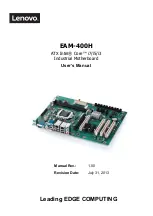
19
Chapter 1: Introduction
1.5 ACPI Features
The Advanced Configuration and Power Interface (ACPI) specification defines a flexible and
abstract hardware interface that provides a standard way to integrate power management
features throughout a computer system, including its hardware, operating system and
application software. This enables the system to automatically turn on and off peripherals
such as CD-ROMs, network cards, hard disk drives and printers.
In addition to enabling operating system-directed power management, ACPI also provides a
generic system event mechanism for Plug and Play, and an operating system-independent
interface for configuration control. ACPI leverages the Plug and Play BIOS data structures,
while providing a processor architecture-independent implementation that is compatible with
appropriate Windows operating systems. For detailed information regarding OS support, refer
to the Supermicro website.
1.6 Power Supply
The X13SAV-LVDS motherboard supports both +12V DC and ATX power input. Either option
requires an 8-pin 12V connection to the JPV1 header, with an ATX power signal input requiring
an additional connection using PN: CBL-PWEX-1063/1066 between header JPWR1 and the
24-pin power connector of an ATX power supply. JPWR1 allows motherboard control of the
5VStby, power on, power good, and ground signals from the ATX power supply. Refer to the
diagram below for the proper connection to JPWR1 and ATX power input.
It is strongly recommended that you use a high quality power supply that meets ATX power
supply Specification 2.02 or above.
Connector Part Number:
CBL-PWEX-1063
or
CBL-PWEX-1066
Figure 1-5. Power Connections















































